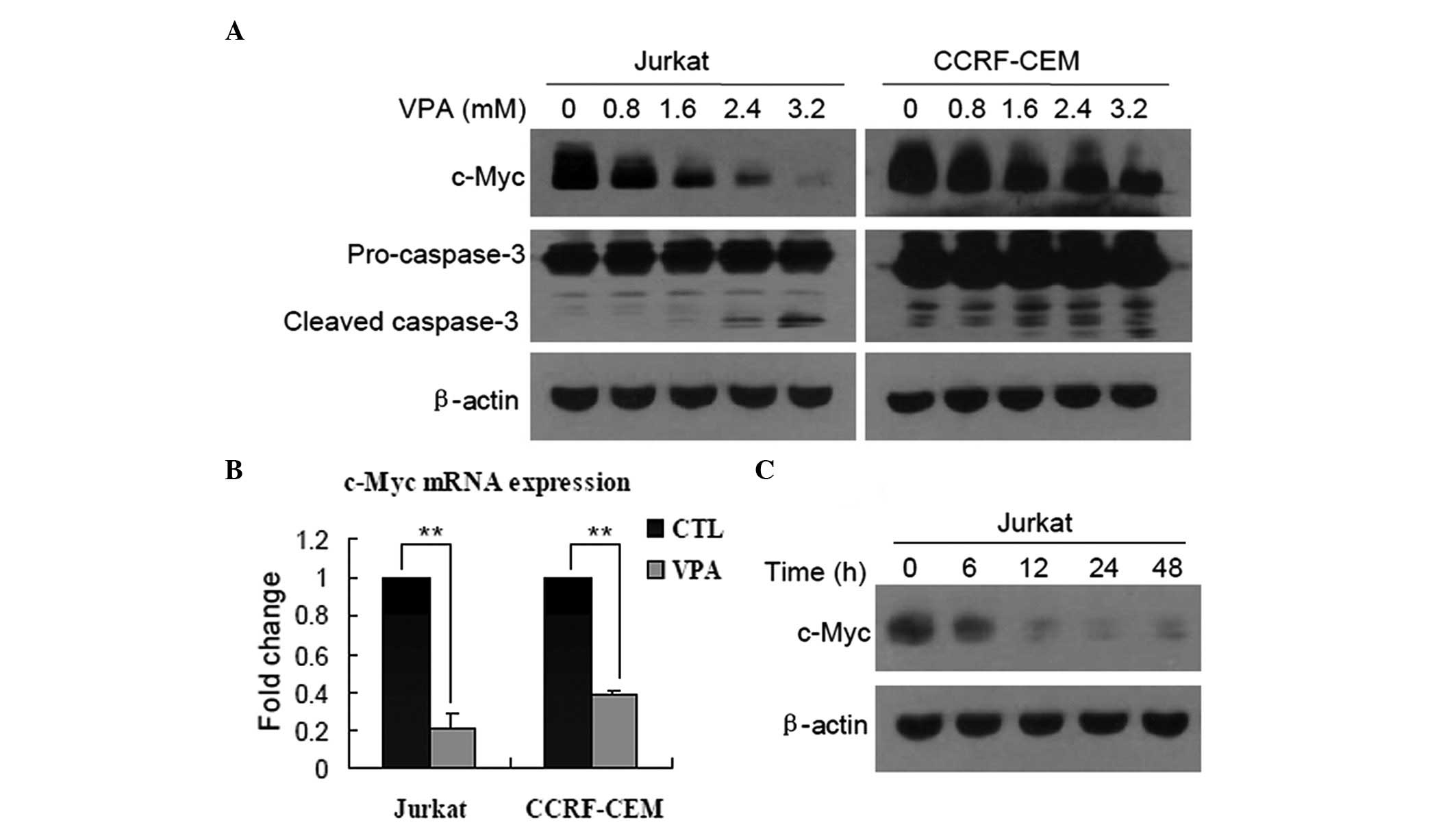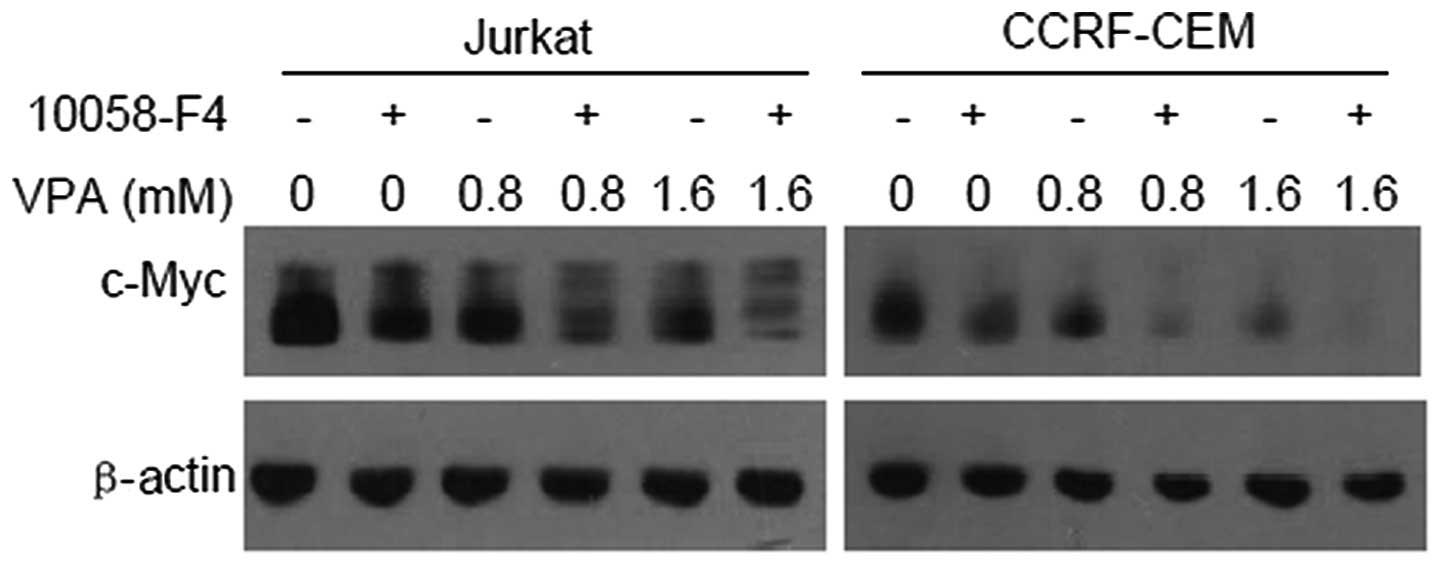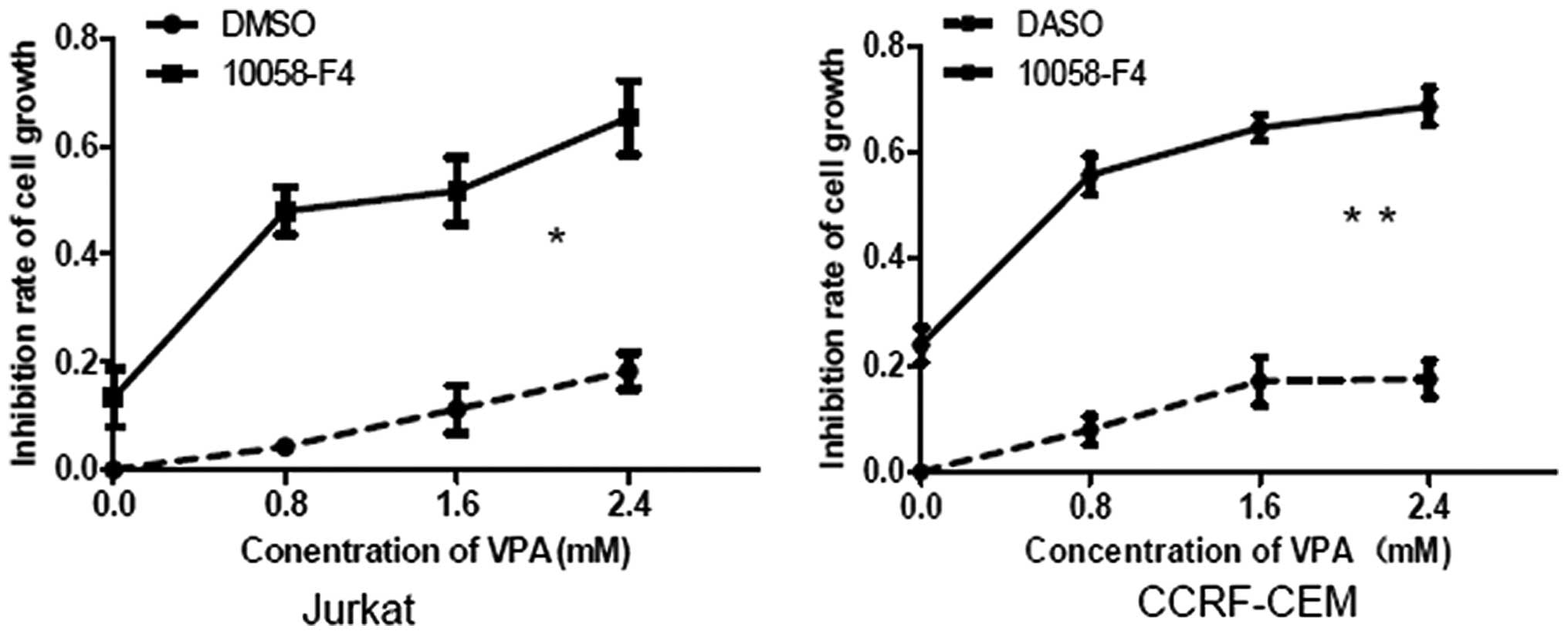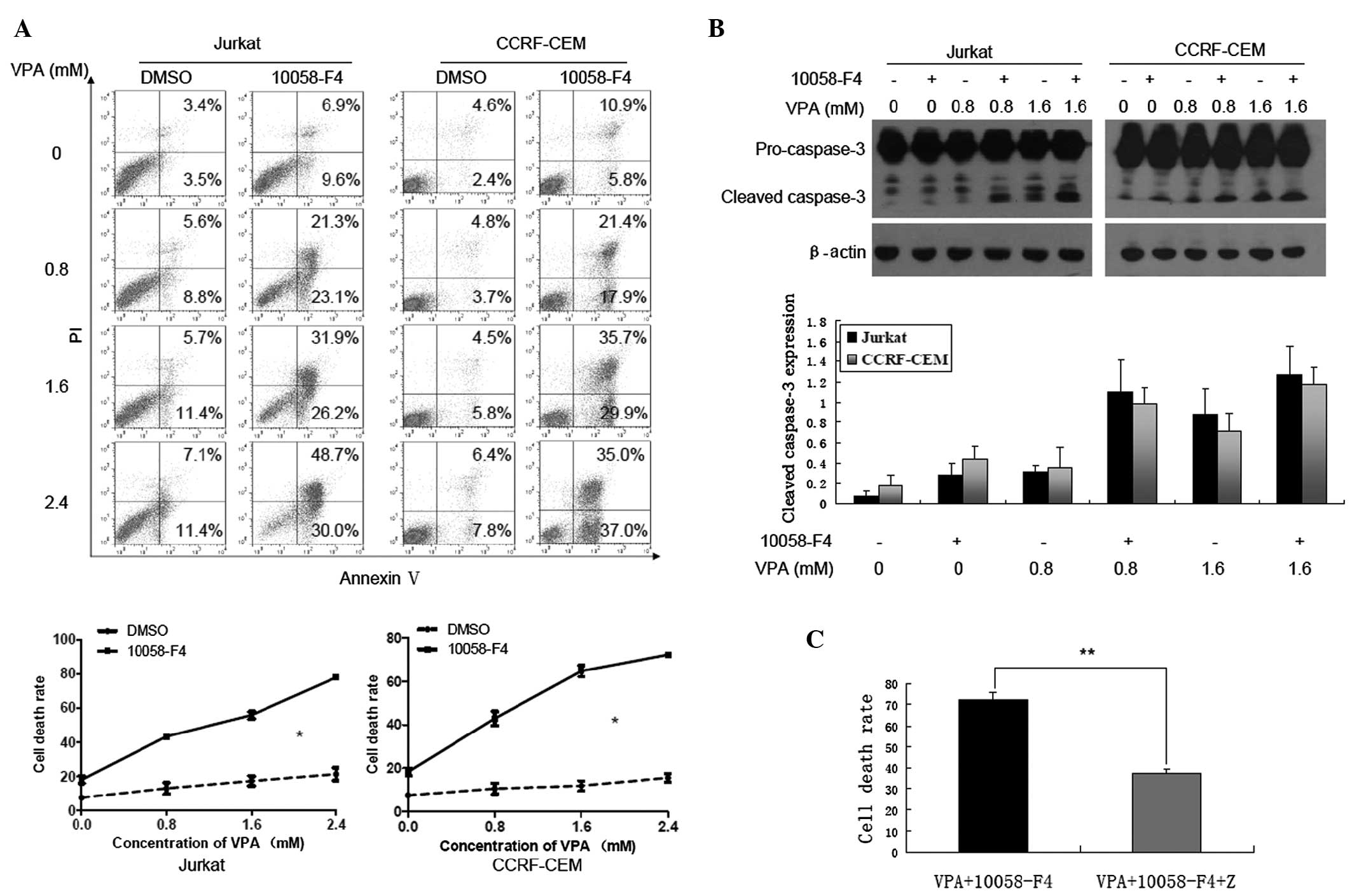|
1
|
Demarest RM, Ratti F and Capobianco AJ:
It’s T-ALL about Notch. Oncogene. 27:5082–5091. 2008.
|
|
2
|
Weng AP, Ferrando AA, Lee W, et al:
Activating mutations of NOTCH1 in human T cell acute lymphoblastic
leukemia. Science. 306:269–271. 2004.
|
|
3
|
Sarmento LM and Barata JT: Therapeutic
potential of Notch inhibition in T-cell acute lymphoblastic
leukemia: rationale, caveats and promises. Expert Rev Anticancer
Ther. 11:1403–1415. 2011.
|
|
4
|
Thompson BJ, Jankovic V, Gao J, et al:
Control of hematopoietic stem cell quiescence by the E3 ubiquitin
ligase Fbw7. J Exp Med. 205:1395–1408. 2008.
|
|
5
|
Weng AP, Millholland JM, Yashiro-Ohtani Y,
et al: c-Myc is an important direct target of Notch1 in T-cell
acute lymphoblastic leukemia/lymphoma. Genes Dev. 20:2096–2109.
2006.
|
|
6
|
Malempati S, Tibbitts D, Cunningham M, et
al: Aberrant stabilization of c-Myc protein in some lymphoblastic
leukemias. Leukemia. 20:1572–1581. 2006.
|
|
7
|
Shao N, Ma D, Wang J, Lu T, Guo Y and Ji
C: Notch1 signaling is irresponsible to the anti-leukemic effect of
HDACis in B-ALL Nalm-6 cells. Ann Hematol. 92:33–39. 2013.
|
|
8
|
Nie D, Huang K, Yin S, et al:
Synergistic/additive interaction of valproic acid with bortezomib
on proliferation and apoptosis of acute myeloid leukemia cells.
Leuk Lymphoma. 53:2487–2495. 2012.
|
|
9
|
Kuendgen A, Knipp S, Fox F, et al: Results
of a phase 2 study of valproic acid alone or in combination with
all-trans retinoic acid in 75 patients with myelodysplastic
syndrome and relapsed or refractory acute myeloid leukemia. Ann
Hematol. 84:61–66. 2005.
|
|
10
|
Sanchez-Gonzalez B, Yang H, Bueso-Ramos C,
et al: Antileukemia activity of the combination of an anthracycline
with a histone deacetylase inhibitor. Blood. 108:1174–1182.
2006.
|
|
11
|
Yang H, Hoshino K, Sanchez-Gonzalez B,
Kantarjian H and Garcia-Manero G: Antileukemia activity of the
combination of 5-aza-2′-deoxycytidine with valproic acid. Leuk Res.
29:739–748. 2005.
|
|
12
|
Leiva M, Moretti S, Soilihi H, et al:
Valproic acid induces differentiation and transient tumor
regression, but spares leukemia-initiating activity in mouse models
of APL. Leukemia. 26:1630–1637. 2012.
|
|
13
|
Cheng YC, Lin H, Huang MJ, Chow JM, Lin S
and Liu HE: Downregulation of c-Myc is critical for valproic
acid-induced growth arrest and myeloid differentiation of acute
myeloid leukemia. Leuk Res. 31:1403–1411. 2007.
|
|
14
|
Kutuk O, Pedrech A, Harrison P and Basaga
H: Pramanicin induces apoptosis in Jurkat leukemia cells: a role
for JNK, p38 and caspase activation. Apoptosis. 10:597–609.
2005.
|
|
15
|
Huang MJ, Cheng YC, Liu CR, Lin S and Liu
HE: A small-molecule c-Myc inhibitor, 10058-F4, induces cell-cycle
arrest, apoptosis, and myeloid differentiation of human acute
myeloid leukemia. Exp Hematol. 34:1480–1489. 2006.
|
|
16
|
Holien T, Vatsveen TK, Hella H, et al:
Bone morphogenetic proteins induce apoptosis in multiple myeloma
cells by Smad-dependent repression of MYC. Leukemia. 26:1073–1080.
2012.
|
|
17
|
Masetti R, Serravalle S, Biagi C and
Pession A: The role of HDACs inhibitors in childhood and
adolescence acute leukemias. J Biomed Biotechnol.
2011:1480462011.
|
|
18
|
Dokmanovic M, Clarke C and Marks PA:
Histone deacetylase inhibitors: overview and perspectives. Mol
Cancer Res. 5:981–989. 2007.
|
|
19
|
Fandy TE, Shankar S, Ross DD, Sausville E
and Srivastava RK: Interactive effects of HDAC inhibitors and TRAIL
on apoptosis are associated with changes in mitochondrial functions
and expressions of cell cycle regulatory genes in multiple myeloma.
Neoplasia. 7:646–657. 2005.
|
|
20
|
Heider U, Kaiser M, Sterz J, et al:
Histone deacetylase inhibitors reduce VEGF production and induce
growth suppression and apoptosis in human mantle cell lymphoma. Eur
J Haematol. 76:42–50. 2006.
|
|
21
|
Zhao ZN, Bai JX, Zhou Q, et al: TSA
suppresses miR-106b-93-25 cluster expression through downregulation
of MYC and inhibits proliferation and induces apoptosis in human
EMC. PLoS One. 7:e451332012.
|
|
22
|
O’Neil J, Grim J, Strack P, et al: FBW7
mutations in leukemic cells mediate NOTCH pathway activation and
resistance to gamma-secretase inhibitors. J Exp Med. 204:1813–1824.
2007.
|
|
23
|
Kawagoe R, Kawagoe H and Sano K: Valproic
acid induces apoptosis in human leukemia cells by stimulating both
caspase-dependent and -independent apoptotic signaling pathways.
Leuk Res. 26:495–502. 2002.
|
|
24
|
Xie C, Edwards H, Xu X, et al: Mechanisms
of synergistic antileukemic interactions between valproic acid and
cytarabine in pediatric acute myeloid leukemia. Clin Cancer Res.
16:5499–5510. 2010.
|
|
25
|
Jasek E, Lis GJ, Jasinska M, Jurkowska H
and Litwin JA: Effect of histone deacetylase inhibitors
trichostatin A and valproic acid on etoposide-induced apoptosis in
leukemia cells. Anticancer Res. 32:2791–2799. 2012.
|
|
26
|
Wang AH, Wei L, Chen L, et al: Synergistic
effect of bortezomib and valproic acid treatment on the
proliferation and apoptosis of acute myeloid leukemia and
myelodysplastic syndrome cells. Ann Hematol. 90:917–931. 2011.
|
|
27
|
Schwartz C, Palissot V, Aouali N, et al:
Valproic acid induces non-apoptotic cell death mechanisms in
multiple myeloma cell lines. Int J Oncol. 30:573–582. 2007.
|
|
28
|
Prochownik EV and Vogt PK: Therapeutic
Targeting of Myc. Genes Cancer. 1:650–659. 2010.
|
|
29
|
Ott CJ, Kopp N, Bird L, et al: BET
bromodomain inhibition targets both c-Myc and IL7R in high-risk
acute lymphoblastic leukemia. Blood. 120:2843–2852. 2012.
|
|
30
|
Filippakopoulos P, Qi J, Picaud S, et al:
Selective inhibition of BET bromodomains. Nature. 468:1067–1073.
2010.
|













